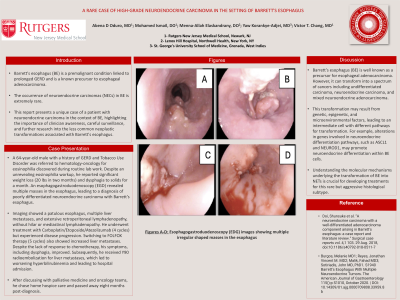Tuesday Poster Session
Category: Esophagus
P3966 - A Rare Case of High-Grade Neuroendocrine Carcinoma in the Setting of Barrett's Esophagus
Tuesday, October 29, 2024
10:30 AM - 4:00 PM ET
Location: Exhibit Hall E

Has Audio
- MI
Mohamed Ismail, DO
Rutgers New Jersey Medical School, NJ
Presenting Author(s)
Abena D Oduro, MD1, Mohamed Ismail, DO1, Menna-Allah Elaskandrany, DO2, Yaw Korankye-Adjei, MD3, Victor T. Chang, MD1
1Rutgers New Jersey Medical School, Newark, NJ; 2Lenox Hill Hospital, Northwell Health, Astoria, NY; 3St. George's University School of Medicine, Brooklyn, NY
Introduction: Barrett's esophagus (BE) is a premalignant condition linked to prolonged GERD and is a known precursor to esophageal adenocarcinoma. However, the occurrence of neuroendocrine carcinomas (NECs) in BE is extremely rare. This report presents a unique case of a patient with neuroendocrine carcinoma in the context of BE, highlighting the importance of clinician awareness, careful surveillance, and further research into the less common neoplastic transformations associated with Barrett's esophagus.
Case Description/Methods: A 64-year-old male with a history of GERD and Tobacco Use Disorder was referred to hematology-oncology for eosinophilia discovered during routine lab work. Despite an unrevealing eosinophilia workup, he reported significant weight loss (20 lbs in two months) and dysphagia to solids for a month. An esophagogastroduodenoscopy (EGD) revealed multiple masses in the esophagus, leading to a diagnosis of poorly differentiated neuroendocrine carcinoma with Barrett’s esophagus. Imaging showed a patulous esophagus, multiple liver metastases, and extensive retroperitoneal lymphadenopathy, without hilar or mediastinal lymphadenopathy. He underwent treatment with Carboplatin/Etoposide/Atezolizumab (4 cycles) but experienced disease progression. Switching to FOLFOX therapy (5 cycles) also showed increased liver metastases. Despite the lack of response to chemotherapy, his symptoms, including dysphagia, improved. Subsequently, he received Y90 radioembolization for liver metastases, which led to worsening hyperbilirubinemia and leading to hospital admission. After discussing with palliative medicine and oncology teams, he chose home hospice care and passed away eight months post-diagnosis.
Discussion: Barrett’s esophagus (BE) is well known as a precursor for esophageal adenocarcinoma. However, it can transform into a spectrum of cancers including undifferentiated carcinoma, neuroendocrine carcinoma, and mixed neuroendocrine adenocarcinoma. This transformation may result from genetic, epigenetic, and microenvironmental factors, leading to an intermediate cell with different pathways for transformation. For example, alterations in genes involved in neuroendocrine differentiation pathways, such as ASCL1 and NEUROD1, may promote neuroendocrine differentiation within BE cells. Understanding the molecular mechanisms underlying the transformation of BE into NETs is crucial for developing treatments for this rare but aggressive histological subtype.

Disclosures:
Abena D Oduro, MD1, Mohamed Ismail, DO1, Menna-Allah Elaskandrany, DO2, Yaw Korankye-Adjei, MD3, Victor T. Chang, MD1. P3966 - A Rare Case of High-Grade Neuroendocrine Carcinoma in the Setting of Barrett's Esophagus, ACG 2024 Annual Scientific Meeting Abstracts. Philadelphia, PA: American College of Gastroenterology.
1Rutgers New Jersey Medical School, Newark, NJ; 2Lenox Hill Hospital, Northwell Health, Astoria, NY; 3St. George's University School of Medicine, Brooklyn, NY
Introduction: Barrett's esophagus (BE) is a premalignant condition linked to prolonged GERD and is a known precursor to esophageal adenocarcinoma. However, the occurrence of neuroendocrine carcinomas (NECs) in BE is extremely rare. This report presents a unique case of a patient with neuroendocrine carcinoma in the context of BE, highlighting the importance of clinician awareness, careful surveillance, and further research into the less common neoplastic transformations associated with Barrett's esophagus.
Case Description/Methods: A 64-year-old male with a history of GERD and Tobacco Use Disorder was referred to hematology-oncology for eosinophilia discovered during routine lab work. Despite an unrevealing eosinophilia workup, he reported significant weight loss (20 lbs in two months) and dysphagia to solids for a month. An esophagogastroduodenoscopy (EGD) revealed multiple masses in the esophagus, leading to a diagnosis of poorly differentiated neuroendocrine carcinoma with Barrett’s esophagus. Imaging showed a patulous esophagus, multiple liver metastases, and extensive retroperitoneal lymphadenopathy, without hilar or mediastinal lymphadenopathy. He underwent treatment with Carboplatin/Etoposide/Atezolizumab (4 cycles) but experienced disease progression. Switching to FOLFOX therapy (5 cycles) also showed increased liver metastases. Despite the lack of response to chemotherapy, his symptoms, including dysphagia, improved. Subsequently, he received Y90 radioembolization for liver metastases, which led to worsening hyperbilirubinemia and leading to hospital admission. After discussing with palliative medicine and oncology teams, he chose home hospice care and passed away eight months post-diagnosis.
Discussion: Barrett’s esophagus (BE) is well known as a precursor for esophageal adenocarcinoma. However, it can transform into a spectrum of cancers including undifferentiated carcinoma, neuroendocrine carcinoma, and mixed neuroendocrine adenocarcinoma. This transformation may result from genetic, epigenetic, and microenvironmental factors, leading to an intermediate cell with different pathways for transformation. For example, alterations in genes involved in neuroendocrine differentiation pathways, such as ASCL1 and NEUROD1, may promote neuroendocrine differentiation within BE cells. Understanding the molecular mechanisms underlying the transformation of BE into NETs is crucial for developing treatments for this rare but aggressive histological subtype.

Figure: Esophagogastroduodenoscopy (EDG) images showing multiple irregular shaped masses in the esophagus
Disclosures:
Abena D Oduro indicated no relevant financial relationships.
Mohamed Ismail indicated no relevant financial relationships.
Menna-Allah Elaskandrany indicated no relevant financial relationships.
Yaw Korankye-Adjei indicated no relevant financial relationships.
Victor T. Chang indicated no relevant financial relationships.
Abena D Oduro, MD1, Mohamed Ismail, DO1, Menna-Allah Elaskandrany, DO2, Yaw Korankye-Adjei, MD3, Victor T. Chang, MD1. P3966 - A Rare Case of High-Grade Neuroendocrine Carcinoma in the Setting of Barrett's Esophagus, ACG 2024 Annual Scientific Meeting Abstracts. Philadelphia, PA: American College of Gastroenterology.
